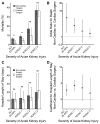Minor Postoperative Increases of Creatinine Are Associated with Higher Mortality and Longer Hospital Length of Stay in Surgical Patients
- PMID: 26492475
- PMCID: PMC4679549
- DOI: 10.1097/ALN.0000000000000891
Minor Postoperative Increases of Creatinine Are Associated with Higher Mortality and Longer Hospital Length of Stay in Surgical Patients
Abstract
Background: Surgical patients frequently experience postoperative increases in creatinine levels. The authors hypothesized that even small increases in postoperative creatinine levels are associated with adverse outcomes.
Methods: The authors examined the association of postoperative changes from preoperative baseline creatinine with all-cause in-hospital mortality and hospital length of stay (HLOS) in a retrospective analysis of surgical patients at a single tertiary care center between January 2006 and June 2012.
Results: The data of 39,369 surgical patients (noncardiac surgery n = 37,345; cardiac surgery n = 2,024) were analyzed. Acute kidney injury (AKI)-by definition of the Kidney Disease: Improving Global Outcome group-was associated with a five-fold higher mortality (odds ratio [OR], 4.8; 95% CI, 4.1 to 5.7; P < 0.001) and a longer HLOS of 5 days (P < 0.001) after adjusting for age, sex, comorbidities, congestive heart failure, preoperative hemoglobin, preoperative creatinine, exposure to radiocontrast agent, type of surgery, and surgical AKI risk factors. Importantly, even minor creatinine increases (Δcreatinine 25 to 49% above baseline but < 0.3 mg/dl) not meeting AKI criteria were associated with a two-fold increased risk of death (OR, 1.7; 95% CI, 1.3 to 2.4; P < 0.001) and 2 days longer HLOS (P < 0.001). This was more pronounced in noncardiac surgery patients. Patients with minor creatinine increases had a five-fold risk of death (OR, 5.4; 95% CI, 1.5 to 20.3; P < 0.05) and a 3-day longer HLOS (P < 0.01) when undergoing noncardiac surgery.
Conclusions: Even minor postoperative increases in creatinine levels are associated with adverse outcomes. These results emphasize the importance to find effective therapeutic approaches to prevent or treat even mild forms of postoperative kidney dysfunction to improve surgical outcomes.
Conflict of interest statement
Competing Interests
All the authors declare no competing interests for the submitted work. Outside the submitted work, Dr. Kork received grants from the German Academic Exchange Service (Bonn, Germany) and the German Federal Ministry of Commerce (Berlin, Germany). Outside the submitted work, Dr. Spies received grants from the Ethical Committee Vienna Faculty of Medicine (Vienna, Austria), Zon-Mw-Dutch Research Community (The Hague, The Netherlands), CareFusion (San Diego, California), Deltex (Chichester, United Kingdom), Fresenius (Bad Homburg, Germany), Hutchinson (Salem, Massachusetts), MCN (Nürnberg, Germany), Novartis (Basel, Switzerland), Pajunk (Geisingen, Germany), Grünenthal (Aachen, Germany), Köhler Chemie (Bensheim, Germany), Roche (Rotkreuz, Switzerland), Orion Pharma (Espoo, Finland), Outcome Europe Sàrl (Nyon, Switzerland), University Hospital Stavanger (Stavanger, Norway), AiF (Köln, Germany), BDA (Nürnberg, Germany), BMBF (Berlin, Germany), DKH (Bonn, Germany), DLR (Köln, Germany), DFG (Bonn, Germany), GIZ (Bonn, Germany), Inner University Grants (Berlin, Germany), Stifterverband für die Deutsche Wissenschaft (Essen, Germany), and European Commission (Brussels, Belgium), and personal fees from B. Braun Foundation (Melsungen, Germany), ConvaTec International Service GmbH (Schaffhausen, Switzerland), Pfizer Pharma (New York City, New York), Vifor Pharma (Glattbrugg, Switzerland), Fresenius Kabi (Bad Homburg, Germany), Georg Thieme Verlag (Stuttgart, Germany). Dr. Eltzschig reports grants from the Crohn’s and Colitis Foundation (New York, New York).
Figures



References
-
- Weiser TG, Regenbogen SE, Thompson KD, Haynes AB, Lipsitz SR, Berry WR, Gawande AA. An estimation of the global volume of surgery: A modelling strategy based on available data. Lancet. 2008;372:139–44. - PubMed
-
- Kheterpal S, Tremper KK, Englesbe MJ, O’Reilly M, Shanks AM, Fetterman DM, Rosenberg AL, Swartz RD. Predictors of postoperative acute renal failure after noncardiac surgery in patients with previously normal renal function. Anesthesiology. 2007;107:892–902. - PubMed
-
- Kheterpal S, Tremper KK, Heung M, Rosenberg AL, Englesbe M, Shanks AM, Campbell DA., Jr Development and validation of an acute kidney injury risk index for patients undergoing general surgery: Results from a national data set. Anesthesiology. 2009;110:505–15. - PubMed

